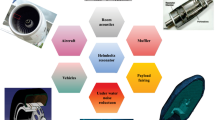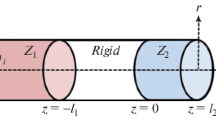Abstract
The article describes an experimental facility for studying and testing sound-absorbing linings made of acoustic metamaterials designed to reduce the noise generated by a source in a finite waveguide. The main focus is on the features of acoustic field formation in a waveguide and its emission from the open ends. The article centers on the results of a study of how different facility parameters influence the efficiency of linings. The large influence of the parameter “type of source” on the lining efficiency has been revealed and investigated for the first time. It is rigorously defined, and the physical mechanism of its influence on the efficiency is described. Conditions are formulated under which the efficiency of a sound-absorbing lining measured on the experimental facility will be equal to or close to its efficiency measured on a real object. It is shown that one of the most important conditions is the coincidence of types of acoustic sources used in the facility with a real one. The results obtained are useful in designing efficient sound-absorbing linings, as well as in creating experimental facilities for their development and testing.




Similar content being viewed by others
Notes
Currently, there are only two international standards according to which the absorption capacity of SA materials is characterized by the absorption coefficient (the ratio of the absorbed and incident power), measured in impedance tubes with normally incident sound [13] and in reverberation chambers in diffuse field conditions [14], when the sound is incident at all angles simultaneously.
REFERENCES
N. N. Andreev, Izv. Akad. Nauk SSSR. Ser. Fiz., No. 5, 625 (1936).
P. M. Morse, J. Acoust. Soc. Am. 11 (2), 205 (1939).
L. L. Beranek, J. Acoust. Soc. Am. 12 (2), 228 (1940).
M. A. Isakovich, General Acoustics (Nauka. Gl. redaktsiya fiz.-mat. lit., Nauka, 1973) [in Russian].
P. M. Morse and K. U. Ingard, Theoretical Acoustics (Princeton Univ. Press, Princeton, NJ, 1986).
M. L. Munjal, Acoustics of Ducts and Mufflers (Wiley, New York, 1977).
L. Cremer, Akust. Beih. 3 (2), 249 (1953).
B. G. Tester, J. Sound Vibr. 27 (4), 477 (1973);
B. G. Tester, J. Sound Vibr. 28 (2), 151 (1973).
A. D. Lapin, Akust. Zh. 21 (3), 337 (1975).
D. V. Bazhenov, L. A. Bazhenova, and A. V. Rimskii-Korsakov, Akust. Zh. 41 (1), 22 (1995).
E. L. Shenderov, Acoust. Phys. 45 (5), 589 (1999).
Formulas of Acoustics, Ed. by F. P. Mechel (Springer-Verlag, Berlin, 2008).
ISO 10534-2: Acoustics—determination of sound absorption coefficient and impedance in impedance tubes (1998).
ISO 354: Acoustics—mesurement of sound absorption in a reverberation room (1985).
R. A. Mangiarotty, J. Acoust. Soc. Am. 48 (3), Part 3, 783 (1970).
E. Rademaker, S. Idzenga, H. Huisman, R. Nijboer, and S. Sarin, in Proc. ICSV10 (Stockholm, 2003).
R. Sugimoto, R. J. Astley, and A. J. Kempton, in Proc. ICSV 11 (St. Petersburg, 2004).
Y. Khaletskiy, V. Povarkov, R. Shipov, and G. Shul, in Proc. ICSV 14 (Cairns, 2007).
T. H. Melling and P. E. Doak, J. Sound Vib. 14 (1), 23 (1971).
A. N. Antoshin, A. G. Zakharov, N. A. Gorodkova, and V. A. Chursin, Vestn. PNIPU, Mekhan., No. 1, 5 (2015).
N. N. Ostrikov, in Proc. 3rd All-Russian Conf. for Young Scientists and Specialists “Habitat Acoustics” (N. E. Bauman State Technical Univ., Moscow, 2018) [in Russian].
Yu. I. Bobrovnitskii and T. M. Tomilina, Acoust. Phys. 64 (5), 519 (2018).
X. Wang and G.-M. Mak, J. Acoust. Soc. Am. 131 (2), 1172 (2012).
Y. Auregan, M. Farooqui, and J.-P. Groby, J. Acoust. Soc. Am. 139 (5), EL149 (2016).
L. Cremer, J. Sound Vib. 16 (1), 1 (1971).
A. D. Jones, Noise Control Eng. 23, 12 (1984).
H. Boden and M. Abom, Acta Acust. 3, 549 (1995).
Y. I. Bobrovnitskii and G. Pavic, J. Sound Vibr. 261, 527 (2003).
D. F. Ross and M. J. Crocker, J. Acoust. Soc. Am. 74 (1), 18 (1983).
Author information
Authors and Affiliations
Corresponding author
Additional information
Translated by A. Carpenter
Rights and permissions
About this article
Cite this article
Bobrovnitskii, Y.I., Tomilina, T.M., Bakhtin, B.N. et al. Laboratory Experimental Facility for Studying Metamaterial Sound-absorbing Duct Linings with Grazing Sound Propagation and How the Type of Source Influences their Efficiency. Acoust. Phys. 66, 324–332 (2020). https://doi.org/10.1134/S106377102003001X
Received:
Revised:
Accepted:
Published:
Issue Date:
DOI: https://doi.org/10.1134/S106377102003001X




